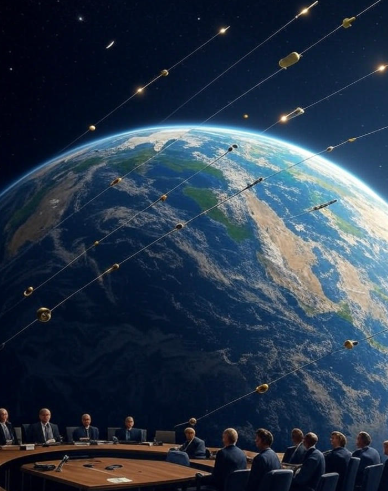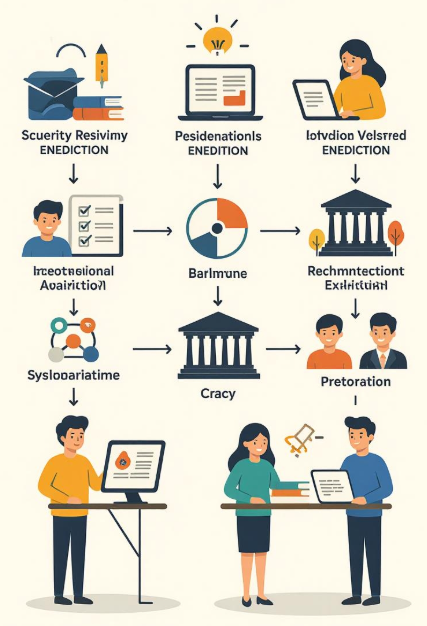Introduction
On May 22, 2025, U.S. President Donald Trump’s Golden Dome missile defense plan, a $175 billion initiative to deploy space-based sensors and interceptors, was met with both anticipation and alarm. Described as a modern revival of Reagan’s “Star Wars” program, the Golden Dome aims to shield the U.S. from missile threats by placing weapons in orbit—a first for the nation. While the plan promises to counter emerging threats from adversaries like China, Russia, and North Korea, it has sparked a global outcry over the militarization of space. The most pressing concern worldwide is that this move could ignite an arms race in space, destabilize international relations, and violate treaties like the 1967 Outer Space Treaty. This blog explores this critical issue and proposes solutions to mitigate the risks while leveraging the Golden Dome to foster global security and cooperation.
The Problem: The Threat of Space Militarization and Global Instability
The Golden Dome plan, which involves a vast network of satellites to detect and intercept missiles, has raised significant concerns about the weaponization of space. This issue resonates globally as nations grapple with the implications of a new era where space becomes a battlefield, potentially reshaping international norms and security dynamics.
1. Escalation of a Space Arms Race
The deployment of space-based weapons under the Golden Dome plan could provoke other nations to follow suit. China has expressed “grave concern,” warning that the project’s “offensive nature” undermines global stability, while Russia suggests it may lead to new nuclear arms control talks. Analysts fear that nations like China and Russia, already advancing their own space capabilities, might deploy similar systems or develop countermeasures, such as anti-satellite weapons, to neutralize the Golden Dome. This tit-for-tat escalation could spiral into a full-fledged arms race in space, increasing the risk of conflict and diverting resources from critical global challenges like climate change and poverty.
2. Violation of International Space Treaties
The 1967 Outer Space Treaty, signed by over 100 countries including the U.S., prohibits the placement of weapons of mass destruction in space and mandates that space be used for peaceful purposes. While the Golden Dome’s interceptors are not nuclear, their deployment as offensive weapons in orbit raises questions about compliance with the treaty’s spirit. Critics argue that this move sets a dangerous precedent, potentially encouraging other nations to reinterpret or abandon the treaty, leading to a lawless space environment where military dominance overshadows cooperation.
3. Geopolitical Tensions and Strategic Instability
The Golden Dome exacerbates tensions with major space powers. China’s Foreign Ministry has accused the U.S. of pursuing an “America First” policy that prioritizes its own security over global stability, while Russia warns of “deeply destabilizing” effects. Smaller nations, like North Korea and Iran, may accelerate their missile programs to evade the shield, further complicating global security. The involvement of U.S. allies, such as Canada, in the project could also strain their relations with other countries, creating new diplomatic rifts and undermining international efforts to address shared challenges like space debris and satellite safety.
4. Technological and Financial Risks
The Golden Dome’s ambitious scope—potentially requiring thousands of satellites—comes with significant hurdles. The Congressional Budget Office estimates costs could reach $542 billion over 20 years, far exceeding Trump’s $175 billion projection. Funding remains uncertain, tied to a contentious $150 billion defense package facing congressional opposition. Technologically, intercepting hypersonic and ballistic missiles in space is a “wicked hard problem,” as experts note, with untested systems risking failure. A malfunctioning or ineffective Golden Dome could embolden adversaries, waste taxpayer money, and erode public trust in space initiatives.

The Solution: Mitigating Risks and Promoting Global Stability
While the Golden Dome plan poses significant risks, it also presents an opportunity to address global concerns about space militarization through transparency, cooperation, and innovation. Here’s how the U.S. can navigate this new frontier responsibly while advancing its security goals.
1. Establishing a Transparent Framework for Space Activities
To alleviate fears of an arms race, the U.S. should lead by example with a transparent framework for the Golden Dome’s deployment. This includes publicly sharing non-sensitive details about the system’s capabilities, such as its focus on defensive interception rather than offensive strikes, and clarifying its compliance with the Outer Space Treaty. By engaging with the United Nations Committee on the Peaceful Uses of Outer Space, the U.S. can demonstrate its commitment to international norms, reassuring other nations and reducing the likelihood of retaliatory militarization.
2. Fostering International Collaboration on Space Security
The Golden Dome can serve as a catalyst for global cooperation rather than conflict. The U.S. should invite allies and neutral nations to participate in the program, not just as contributors but as partners in shaping its governance. Canada’s interest in joining the project, as noted by Trump, is a starting point. Expanding this collaboration to include nations like Japan, the EU, and India could create a coalition dedicated to space security, sharing technology and intelligence to counter missile threats collectively. This approach would dilute perceptions of U.S. dominance, foster trust, and encourage adversaries like China and Russia to engage in dialogue rather than escalation.
3. Negotiating New Arms Control Agreements
To prevent a space arms race, the U.S. should proactively pursue arms control talks with Russia and China, as suggested by the Kremlin. These negotiations could lead to a new treaty specifically addressing space-based weapons, setting limits on their deployment and establishing verification mechanisms. For instance, an agreement could cap the number of interceptors in orbit and ban offensive space weapons, ensuring the Golden Dome remains a defensive tool. By tying these talks to broader nuclear arms control discussions, the U.S. can address Russia’s concerns while promoting strategic stability, reducing the risk of conflict in space.
4. Leveraging Technology for Dual-Use Benefits
The Golden Dome’s satellite network, which includes advanced sensors from companies like L3Harris, can be repurposed for peaceful applications, mitigating concerns about militarization. For example, these sensors could monitor space debris, track climate change indicators, or support global disaster response by providing real-time data on natural phenomena. By integrating dual-use capabilities, the U.S. can demonstrate that the Golden Dome contributes to global good, not just national security. This approach could win support from nations wary of space weaponization, turning a potential point of contention into a collaborative asset.
5. Ensuring Accountability and Oversight
To address financial and technological risks, the U.S. must establish robust oversight mechanisms for the Golden Dome. This includes independent audits of the project’s budget, currently tied to a $25 billion initial investment, to ensure funds are used efficiently and not siphoned off by defense contractors like SpaceX, Palantir, and Anduril, which are frontrunners for the project. Technologically, the U.S. Space Force, led by General Michael Guetlein, should conduct rigorous testing phases, starting with small-scale deployments to validate the system’s effectiveness before full-scale implementation. Transparency in these processes will build public and congressional confidence, ensuring the project’s success without derailing other national priorities.
Challenges and Future Outlook
Implementing these solutions will face hurdles. Arms control talks with Russia and China are historically contentious, and domestic political opposition to the Golden Dome’s funding could delay progress. Technologically, achieving reliable missile interception in space remains a complex challenge, requiring years of development beyond Trump’s three-year timeline. However, by prioritizing transparency, cooperation, and dual-use benefits, the U.S. can mitigate the risks of space militarization, turning the Golden Dome into a symbol of responsible innovation. In the long term, this approach could pave the way for a new era of space governance, where security and collaboration coexist.
Conclusion
Trump’s Golden Dome plan, announced on May 22, 2025, has thrust the issue of space militarization into the global spotlight, raising valid concerns about arms races, treaty violations, and geopolitical instability. Yet, it also offers a chance to redefine how nations approach space security. By fostering transparency, international collaboration, arms control, dual-use technology, and rigorous oversight, the U.S. can address these global concerns while advancing its defense goals. The Golden Dome need not launch a new era of conflict in space, instead, it can mark the beginning of a more cooperative, secure, and innovative future for humanity’s final frontier.



